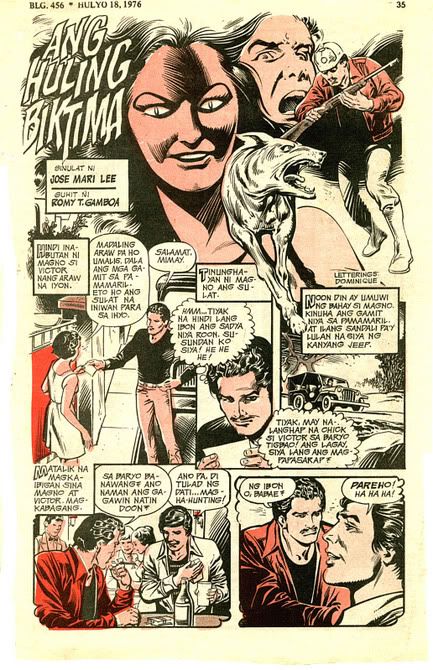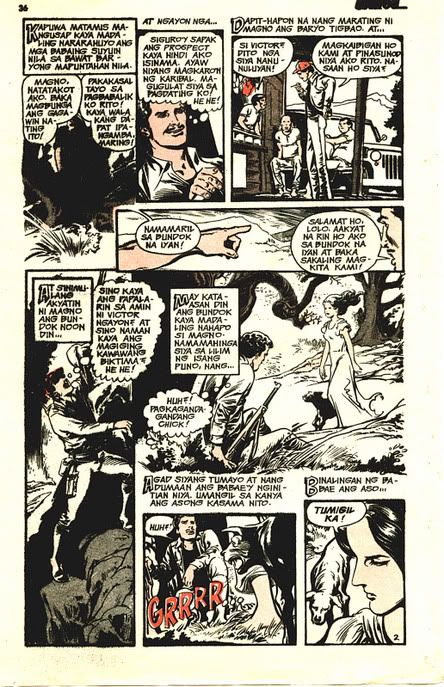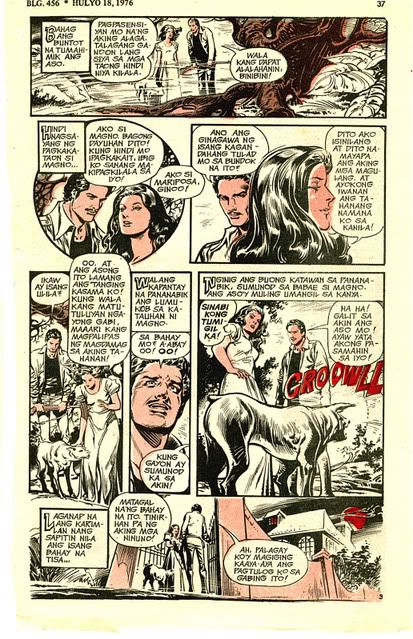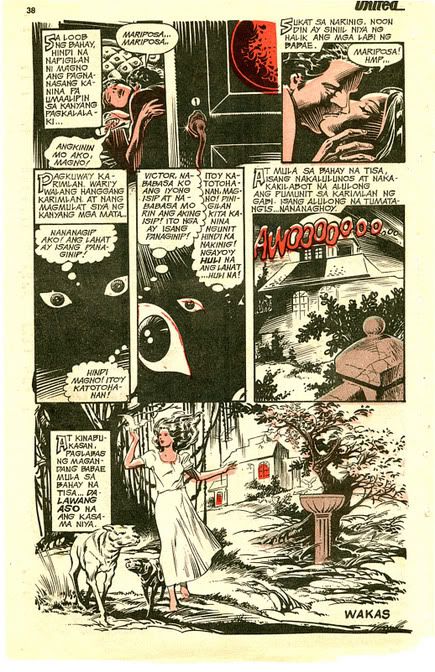PINOY•COMICS•TV•MOVIES
Anything concerning Filipino Movies, Comic Books, & Television.
Monday, June 30, 2008
Saturday, June 28, 2008
WRITING 101-PART3-CREATING A CHARACTER or WHY DID THE TITANIC SINK?

Answer: BECAUSE OF THE PESKY ICEBERG!
A character in a story is like an ice berg: only 1/5 of it is revealed to the vision of the beholder (the reader). The bigger chunk of it is hidden deep in the water. In the creation of a character, it is deliberately hidden because if everything is reveled all at once, there will be no more challenge to the reader.
However, it is MANDATORY that the writer who is creating this character must know his character inside out, or else, like the Titanic, he will bump against this ice berg and eventually sink.
Look at the image.
Area A is what the reader only sees. This area is the story proper. This is the world of your character where the story is taking place.
Area B is what the reader never sees, but an area that the writer must mandatorily know. Because, if you don't know your character inside out as the author... who will? Not Madame Auring or Rene Mariano for sure.
So what are we supposed to do to build a convincing, creative, authentic character that breathes with life?
A CHARACTER DOSSIER
Have a character sheet. Right down her name, her birthdate, her status in life, her mental capacity. Make sure to indicate her MAIN CHARACTER TRAIT and secondary character trait.
What is her:
• Religion
• Morals and sexual drive
• Superstitions
• Ambitions
• Desires
• Goals
• Height
• Weight
• Color of eyes, hair, complexion
• Posture, gait
• Eating habits
• appearance
• Health
• Nationality
• Social Class (both in ther [past & the present)
• I.Q. (intelligent or Boba)
• Home Life (When growing up– attitude towards parents, sibblings, relatives, friends, strangers)
• Amusements, hobbies, pleasures
• Faults and weaknesses
• Props in life: Cane? Baseball cap, jewellry. weapons, wheelchair
• Temperament
• Introvert/extrovert
• Imagination, sense of humor, weirdnes
• Views: environment, race, inequality, politics, issues
• Unusual or habitual gestures, expression, characteristic manner of speaking
• First impression on others
• civil status, sexual preference
and so on.
Do you know someone in real life that stands out? Why? Examine the reasons why. This will help as well. How does she treat herself? Is she too critical about her own personality? Is she over confident? Unsure of herself? Afraid of the world? Can she face and speak before a crowd? Is she shy?
In short, study her from the top of her head to tip of her toes.
Know her physical side, her mental side, her spiritual side if you will.
There is one very useful guide that helps me to create more distinct characters. I use Madame Auring's knowledge of the ZODIAC SIGNS. A pisces is totally different from a Taurus, for instance. A Leo is far from a Cancer. The zodiac opens doors for your characters. It is an open sesame to untold riches.
If you do it this way, every character that you create will be UNIQUE. It will be totally different from another character.
And when you have big scenes where several characters will be present, everyone will be totally distinct from one another. In a play I wrote in 1974 about Male Prostitutes called AMAG SA KARIMLAN, there were 6 call boy characters, 5 badings, and 1 woman. In the scenes where all the call boys appeared, each character is distinct because each one has a totally unique character and diction. Same thing happened with the badings. Though, because there was only one woman in the cast, she became the jewell, so to speak, in the play.
What is so handy with the character dossier is the fact that because you know him too well, whatever he does in the story, you will have all the CONTROL to keep him CONSISTENT within his character make up. In TV, Film & stage writing, distinct characters are a MUST when you have a big scene and all these characters appear in the same scene all together at the same time. If you don't bother to create your character with 3-dimensionality and distinction, I guarantee you that your scene will not survive. It will die a natural death, without a word, without a sigh.
Also, because you know the past of each character, you can suggest facts in the dialogs (in passing), for now, so that later in the story, the reader will be able to tie in all those mysterious dialogs afterwards. This is one good thing about the character dossier. YOU DON'T HAVE TO TELL YOUR AUDIENCE EVERYTHING. They will figure it out by themselves. However, if the past of your character is haphazardly written, it will be tragic for him (your character) and for you (the writer).
It is also good to write well-developed characters, well, maybe in komiks or prose, so that when it is time to translate it into a tele[play or screenplay, you already have the background for each character ready. Now, it will be more crucial to have stronger characters because TV and movies are several times much bigger in scope than komiks, but more restrictive in form than komiks. You see, in komiks, you can show and tell, even the minds of your characters are possible to reveal to the readers. Not in Teleplay or movies. You have to show it since you cannot draw think balloons on screen. With well-developed characters, the battle is half-won when the time comes for you to write the screenplay or teleplay.
Therefore, young writers, be smart. Have a character dossier, also known as the ICE BERG PRINCIPLE. It will make a lot of difference.
Wednesday, June 25, 2008
UNPLOTTED STORY - PART 2
Unplotted character Stories are often called MESSAGE STORIES because of their strong underlying theme. Writers, however, classify them as unplotted character stories, and , as such, they must follow a clearly defined FORM to be effective.
For the untrained, identifying an unplotted story can be difficult because the main character may often have a purpose and have to reach a decision. The unplotted story must also contain the basic element of all other types of stories:
Rule 1: Someone to root for
Rule 2: Something of importance, which must depend on the outcome
Rule 3: A definitive beginning, middle and end.
The difference in an unplotted story is: the purpose (goal/decision) of the main character is NOT the focal point of the story, and often, is not present in the beginning of the story. What is important is the REACTION of the main character to the unique situation in which he finds himself, or into which he is pulled, which is used to illustrate some truth-of-life that the author wishes to convey.
Now, there are five main types of unplotted character stories:
1. Character defeated because of circumstances.
The main character is sympathetic and deserves to achieve his goal or happiness, but in the end, he does not, because life-isn't-always-like-that.
Samples of this type:
• THE GRAPES OF WRATH (STEINBECK)
• DEATH OF A SALESMAN (MILLER)
• THE OLD MAN AND THE SEA (HEMINGWAY)
2. Character defeated because of weakness or obsession.
The main character is interesting and likeable but possessed by a negative dominant trait that drives him to destruction.
Samples of this type:
• MADAME BOVARY (FLAUBERT)
• WUTHERING HEIGHTS (BRONTE)
• RACHEL, RACHEL (MARGARET LAWRENCE)
3. Character prevails because of great sacrifice
The main character is interesting and prevails because of persistence, cleverness or sacrifice... his own, or that of a loved one.
Samples:
• THE AFRICAN QUEEN (C.S. FORRESTER)
• TOM JONES (FIELDING)
• BEAU GESTE (WREN)
4. Character regeneration
The Main character has a negative dominant trait or is controlled by a bad habit, whereby he is driven, led or shocked into benevolence, wisdom or rehabilitation.
Samples:
• CASABLANCA (BURNETTE & ALISON)
• LOST WEEKEND (C.R. JACKSON)
• CHRISTMAS CAROL (DICKENS)
5. Character degeneration
The main character, though interesting/pathetic, deteriorates morally, spiritually or mentally. Just before the end crisis, there is an upward trend, a flicker of hope that the hero will redeem himself, after which he slides downhill)
Samples:
• THE PICTURE OF DORIAN GREY (WILDE)
• DR. JEKYLL AND MR. HYDE (STEVENSON)
• NIGHTMARE ALLEY (W.L. GRESHAM)
All unplotted character stories contain strong CHARACTERIZATIONS, an interesting PROBLEM that builds to a CRISIS, where the end consists of one or more of the following:
1. Revelation of the unjust or pathetic cause of the problem
2. Expression of some sage philosophy or reality of life
3. promise of rehabilitation, usefulness or happiness
Here are some themes of unplotted character stories (again, I will use the classic ones for easy recognition)
THE GRAPES OF WRATH
A family's struggle against destitution and death, which strengthens its spirit to fight for what is right.
DEATH OF A SALESMAN
An average man's hopeless sense of failure in American society as he discovers himself aging.
THE OLD MAN AND THE SEA
Man's inevitable defeat in his struggle with existence – in spite of which, man can fight with dignity, courage and stoicism.
BEAU GESTE
Strong brotherly love prevails even after death.
TOM JONES
Protective devotion and pride can drive one away from his loved ones.
THE AFRICAN QUEEN
Two opposing personalities find love for one another as they bravely fight for survival.
MADAME BOVARY
A woman becomes corrupted as she tries to fulfill childish dreams of romance.
WUTHERING HEIGHTS
An under priveleged man's overt determination for wealth does not necessarily bring happiness.
RACHEL, RACHEL
A daughter's inability to find happiness while she remains under her mother's domination.
CASABLANCA
A hardened self-centered man becomes vulnerable to self-sacrifice when moved by affair of the heart.
Remember that the aim of unplotted stories is not necessarily to create strong suspense or highly satisfying endings, but to produce a definite EMOTION toward the main character in order to illustrate the truth (or theme) which the author wishes to convey.
Always remember that in a an unplotted character story, the character's purpose (goal, decision( is not the focal point of the story and is often not present at the beginning of the story. The main thrust of the story is the THEME.
I hope, those who are asking what exactly is an unplotted story is, have benefited from this post. Most probably, many young writers are now truly aware of what a PLOTTED story is, so we will not touch that topic unless someone sends me an email asking for it. In this case, then, we'll discuss MODERN THEMES next time.
Tuesday, June 24, 2008
WRITING 101: TO PLOT OR NOT TO PLOT, THAT IS THE QUESTION.




A reader named Ramon Lopez has emailed me, asking what exactly, is the difference between a PLOTTED STORY and an UNPLOTTED STORY?
In his book, CREATING SHORT FICTION, author DAMON KNIGHT expounds the basic make-up of a plotted story where he retold the tale of a familiar conflict:
A man in a rooming house was in the habit of taking off his shoes at night and dropping them on the floor one at a time, with a pause for rumination in between. The lodger below had complained about this many times. One night, after dropping the first shoe, the man suddenly remembered the complaints and put the second shoe down gently.
After twenty minutes had passed, an agonized wail came up from the floor below: "For God's sake, drop the other shoe!"
In one way or another, every plotted story makes us wait for the other shoe to drop. We are waiting for the resolution of a conflict, or the solution to a puzzle, or the explanation of a mystery, or just the completion of a pattern, and it is this anticipation, as much as anything else, that makes us read on.
True enough, plotted stories make the readers anticipate what’s going to happen next.
But, in an UNPLOTTED STORY, the readers WILL NEVER KNOW how the story will end. Therefore, the anticipation will be two-fold:
1. There seems to be no familiar indications as to what a reader will expect, and;
2. No definite clear-cut or familiar denoument that the reader could clutch and hang on to take him to the finale.
It is very apparent, therefore, that unplotted stories are less restrictive, less structured, and naturally – much more challenging to both the writer and his reader.
Though both forms have the same characteristics, and ingredients that as an author you must always remember to:
1. Give Someone to root for
2. Something of importance must depend on the outcome of the story
3. The story must contain a clear-cut Beginning, Middle and End
As an author, you must also not overlook to create an interesting main character (if possible, a sympathetic one), who faces obstacles he must overcome to achieve his desired goal. Or, in a nut shell: Desire, opposed by an obstacle, produces emotion.
We know as writers and readers that life means struggle. Yet, how do you, as a writer, achieve the greatest dramatic emotion?
Maximum intensity of desire
Opposed by
Maximum intensity of opposition
Produces
Maximum emotion
And what are the most distinct classifications to achieve this mission as a writer?
A. Obstacle between main character and the physical world
B. Obstacle between main character and another person
C. Obstacle between two desires within the same person
Does unplotted story then, work for the komiks?
Why not? I have done both in the 70s when I used to write komiks script for Atlas Publishing. For Ramon Lopez who emailed me inquiring about the possibilities of unplotted stories’ possibility to work effectively in komiks, here’s one example from the 1970s. I will also post a plotted one for you. It is an example of what I like to write, and that is: “A day in the life of…”
And a plotted story:




Ramon Lopez, as a new writer, you have your preference whether to plot or not to plot. It's all up to you, my son. If you want to write unplotted stories, I suggest you watch , for a starter, the film NASHVILLE by ROBERT ALTMAN. You'll be amazed how refreshing can an unplotted story be.
- Your Father Confessor
Tuesday, June 10, 2008
DOWN MEMORY LANE 3: ROSA ROSAL: PHILIPPINES' GREATEST CHARACTER ACTRESS

When I was a child in the late 60s, I moved to the Bicol region. The first time I set foot in this little town in Sorsogon, culture shock engulfed my whole being. It was an extremely drastic change from the bright lights of the roaring city of Manila to the graveyard-like quiescent of a small town — a ranch to be exact. But soon, I discovered so many fun things to do in this little town: the pristine river, the clean ocean, the warm people, the cool weather. What’s more, this place showed me how beautiful its moonlit nights were, and how majestic, albeit lonely, its sunsets. Unlike Manila with all the amenities of modern living, this place offers not much in terms of entertainment: radio, komiks, and, thank God, the movies.
There were two movie houses in this town. One had 16mm screen, while the other one was considered more state-of-the-art because it had 35mm with a Cinemascope lens to boot — but both were showing older movies. Mostly double or triple bills, usually
a mixture of Hollywood and Tagalog films — that the newest would be at least seven to ten years old!
But to my advantage, because without these old movies, I wouldn’t have had the chance to see great spectacular classics such as the ones directed by Cecil de Mille, Willy Wyler and David Lean; or the heart-rending neo-realist films by Antonioni, Visconti, Rossellini, Puccini, Zavattini, De Santis, De Sica, Fellini, Pasolini, Truffaut. Nor the wonderful Tagalog neo-realist films by Lamberto Avellana, Gerry de Leon; and the biting sarcasm of Manuel Conde’s political satires.
I went to the movies regularly, and read komiks like there were no more tomorrow. Soon, I became interested in drawing and writing. Back then, Tagalog films were done mostly by Sampaguita Pictures, LVN Pictures and Premier Productions. Many were fantasy, adventures, and majority were love stories and domestic drama tear-jerkers.
But, the local films that left some indellible images in my mind were the ones made by Avellana and de Leon. They were less maudlin, more cerebral, and truly entertaining. They also used the crème de la crème actors of Tagalog movies.
And through the films of Avellana, I came to know the acting caliber of a thespian named ROSA ROSAL.
Delicately beautiful and radiating with presence on screen, Rosa Rosal is obviously the epitome of what defines a true performer. She utilizes with precision, her voice and body to tackle a role, and watching her (as a child who didn’t know a thing about acting or filmmaking), I felt the authenticity of every scene that she appeared in. I find every dialog she delivered extremely convincing and absolutely believable. Yet, what really makes her special is her high-caliber use of acting techniques coupled with her masterful layering of characterization.
Flash forward to mid-70s. A newly Mass Comm graduate and was writing barely a year for Alma Moreno’s weekly drama anthology ALINDOG, when Channel 2 offered me to write another weekly drama anthology. Rosa Rosal would be the mainstay actress in a show called ULILA. Without batting an eyelid, I accepted the network’s offer. I already knew how good Rosa Rosal is from the movies I had seen in my childhood, and now I will have the chance to write scripts for her.
The first time we’ve met during a production meeting, I immediately realized that this fabulous actress was not only a very good thespian, but is also a wonderful person: friendly, highly-intelligent, and quite down-to-earth. And there is another thing: she’s a pace-setter just like what a true artist is. And, I should not forget one more thing: she’s highly-principled especially when it involves a person’s civil rights. I remember the advice she told me in one of our many conversations:
“Joe, don’t let anyone step on you. No one has the right to step on anyone. And don’t let anybody in showbiz use you.”
For an eighteen year old, that advice sort of gave me a head's up for what Philippine Showbiz is all about.
I knew right there and then that it would be fun to work with her.
And was I ever right with my first impression. She made sure that she gets her script a week early so that she can study and build the characterization of the role she was going to play for that particular episode. And during tapings, she was way ahead of the other guest performers to come to the studio. She inquired about the full characterization of the role. She makes sure that she knew the complete background of the character she was playing. Then she slowly opens this character like a book, turning pages that builds up the character as the story progresses, making sure that she knew by heart every nook and cranny of the story where her character meets head-on all the obstacles and triumphs, building it logically and dramatically, thus delivering a tour de force performance every week..
Rosa Rosal’s generosity is always there. Helping the poor and the sick is her passion. Being exposed to many incidents in this type of endeavor, she has seen a lot of pain and suffering, of heroism and cowardice, of good and evil. And because of this, she has a wealth of amazing stories that needed to be told. She told me many, many of these stories, true-to-life incidents that I turned into episodes and episodes of ULILA, then TRUE STORY, BATA, SENOR STO. NINO and PEPING ANG MUNTING ANGHEL. Many were heart-rending, yet there were others that were equally exalting to one’s spirits, and many more were truly inspiring. Every week was a trip to terra incognita, a world that only Rosa Rosal had visited, and where she had interacted with true-to-life protagonists and antagonists – and the aftermath of their crossing paths. Every week, while I work for the PR Office of Imelda Marcos, I eagerly awaited Rosa Rosal’s phone call, hoping to hear another true-to-life story that I couldn’t wait to write for another teleplay.
What is so fun writing for Ulila, was the fact that Rosa Rosal isn’t only an extremely brilliant actress, she is also a character with unquestionable integrity in real life. That was a bonus for the show. People believe in her in real life, therefore it follows that they also believe her on TV. She oozes with humility and politeness. She doesn’t have the insolence of other big stars, especially the younger ones who think that they’re on top of the world just because they are well-known and adored by their fans. She worked like an honest-to-goodness artist, and every role she played gleamed and reflected truth - like a summer forest fire burning wildly, that as a viewer, you feel the heat and the blinding light right before your eyes.
Rosa Rosal, no doubt, is a unique Filipino actress.
Performers like her come few and far between. She is the epitome of what a true actress should be: beautiful, gregarious, polite, truthful, innovative, and without a doubt – a high-caliber performer that we see very rarely in Philippine Movies and Television. Rosa Rosal is the Philippines' greatest character actress to the truest sense of this word. A Philippine icon that all Filipinos should be proud of.






